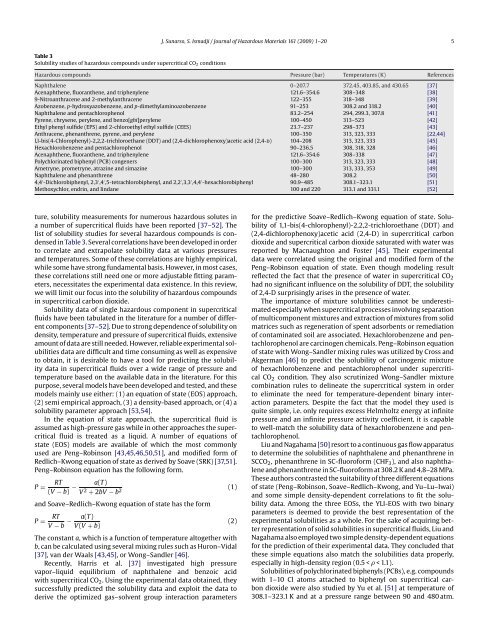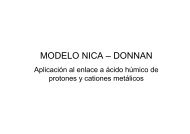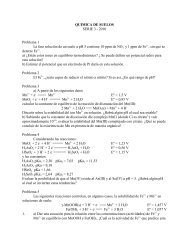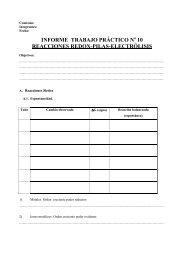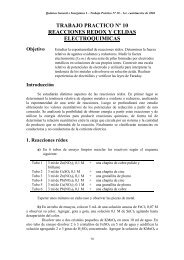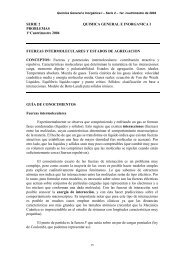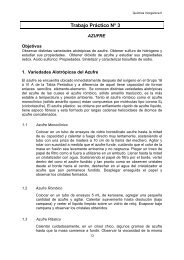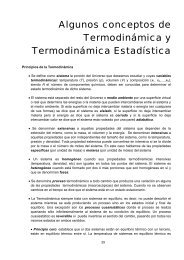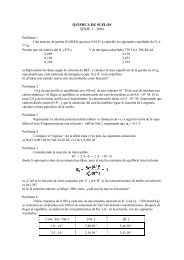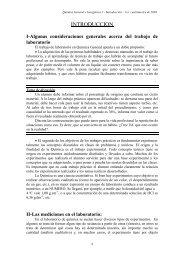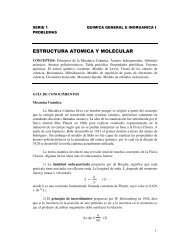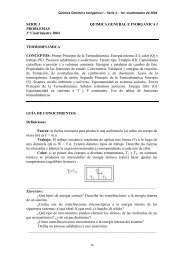Journal of Hazardous Materials Decontamination of hazardous ...
Journal of Hazardous Materials Decontamination of hazardous ...
Journal of Hazardous Materials Decontamination of hazardous ...
Create successful ePaper yourself
Turn your PDF publications into a flip-book with our unique Google optimized e-Paper software.
J. Sunarso, S. Ismadji / <strong>Journal</strong> <strong>of</strong> <strong>Hazardous</strong> <strong>Materials</strong> 161 (2009) 1–20 5Table 3Solubility studies <strong>of</strong> <strong>hazardous</strong> compounds under supercritical CO 2 conditions<strong>Hazardous</strong> compounds Pressure (bar) Temperatures (K) ReferencesNaphthalene 0–207.7 372.45, 403.85, and 430.65 [37]Acenaphthene, fluoranthene, and triphenylene 121.6–354.6 308–348 [38]9-Nitroanthracene and 2-methylanthracene 122–355 318–348 [39]Azobenzene, p-hydroxyazobenzene, and p-dimethylaminoazobenzene 91–253 308.2 and 318.2 [40]Naphthalene and pentachlorophenol 83.2–254 294, 299.3, 307.8 [41]Pyrene, chrysene, perylene, and benzo[ghi]perylene 100–450 313–523 [42]Ethyl phenyl sulfide (EPS) and 2-chloroethyl ethyl sulfide (CEES) 23.7–237 298–373 [43]Anthracene, phenanthrene, pyrene, and perylene 100–350 313, 323, 333 [22,44]l,l-bis(4-Chlorophenyl)-2,2,2-trichloroethane (DDT) and (2,4-dichlorophenoxy)acetic acid (2,4-d) 104–208 313, 323, 333 [45]Hexachlorobenzene and pentachlorophenol 90–236.5 308, 318, 328 [46]Acenaphthene, fluoranthene, and triphenylene 121.6–354.6 308–338 [47]Polychlorinated biphenyl (PCB) congeners 100–300 313, 323, 333 [48]Ametryne, prometryne, atrazine and simazine 100–300 313, 333, 353 [49]Naphthalene and phenanthrene 48–280 308.2 [50]4,4 ′ -Dichlorobiphenyl, 2,3 ′ ,4 ′ ,5-tetrachlorobiphenyl, and 2,2 ′ ,3,3 ′ ,4,4 ′ -hexachlorobiphenyl 90.9–485 308.1–323.1 [51]Methoxychlor, endrin, and lindane 100 and 220 313.1 and 331.1 [52]ture, solubility measurements for numerous <strong>hazardous</strong> solutes ina number <strong>of</strong> supercritical fluids have been reported [37–52]. Thelist <strong>of</strong> solubility studies for several <strong>hazardous</strong> compounds is condensedin Table 3. Several correlations have been developed in orderto correlate and extrapolate solubility data at various pressuresand temperatures. Some <strong>of</strong> these correlations are highly empirical,while some have strong fundamental basis. However, in most cases,these correlations still need one or more adjustable fitting parameters,necessitates the experimental data existence. In this review,we will limit our focus into the solubility <strong>of</strong> <strong>hazardous</strong> compoundsin supercritical carbon dioxide.Solubility data <strong>of</strong> single <strong>hazardous</strong> component in supercriticalfluids have been tabulated in the literature for a number <strong>of</strong> differentcomponents [37–52]. Due to strong dependence <strong>of</strong> solubility ondensity, temperature and pressure <strong>of</strong> supercritical fluids, extensiveamount <strong>of</strong> data are still needed. However, reliable experimental solubilitiesdata are difficult and time consuming as well as expensiveto obtain, it is desirable to have a tool for predicting the solubilitydata in supercritical fluids over a wide range <strong>of</strong> pressure andtemperature based on the available data in the literature. For thispurpose, several models have been developed and tested, and thesemodels mainly use either: (1) an equation <strong>of</strong> state (EOS) approach,(2) semi empirical approach, (3) a density-based approach, or (4) asolubility parameter approach [53,54].In the equation <strong>of</strong> state approach, the supercritical fluid isassumed as high-pressure gas while in other approaches the supercriticalfluid is treated as a liquid. A number <strong>of</strong> equations <strong>of</strong>state (EOS) models are available <strong>of</strong> which the most commonlyused are Peng–Robinson [43,45,46,50,51], and modified form <strong>of</strong>Redlich–Kwong equation <strong>of</strong> state as derived by Soave (SRK) [37,51].Peng–Robinson equation has the following form.P =RT(V − b) − a(T)V 2 + 2bV − b 2 (1)and Soave–Redlich–Kwong equation <strong>of</strong> state has the formP =RTV − b − a(T)(2)V(V + b)The constant a, which is a function <strong>of</strong> temperature altogether withb, can be calculated using several mixing rules such as Huron–Vidal[37], van der Waals [43,45], or Wong–Sandler [46].Recently, Harris et al. [37] investigated high pressurevapor–liquid equilibrium <strong>of</strong> naphthalene and benzoic acidwith supercritical CO 2 . Using the experimental data obtained, theysuccessfully predicted the solubility data and exploit the data toderive the optimized gas–solvent group interaction parametersfor the predictive Soave–Redlich–Kwong equation <strong>of</strong> state. Solubility<strong>of</strong> 1,1-bis(4-chlorophenyl)-2,2,2-trichloroethane (DDT) and(2,4-dichlorophenoxy)acetic acid (2,4-D) in supercritical carbondioxide and supercritical carbon dioxide saturated with water wasreported by Macnaughton and Foster [45]. Their experimentaldata were correlated using the original and modified form <strong>of</strong> thePeng–Robinson equation <strong>of</strong> state. Even though modeling resultreflected the fact that the presence <strong>of</strong> water in supercritical CO 2had no significant influence on the solubility <strong>of</strong> DDT, the solubility<strong>of</strong> 2,4-D surprisingly arises in the presence <strong>of</strong> water.The importance <strong>of</strong> mixture solubilities cannot be underestimatedespecially when supercritical processes involving separation<strong>of</strong> multicomponent mixtures and extraction <strong>of</strong> mixtures from solidmatrices such as regeneration <strong>of</strong> spent adsorbents or remediation<strong>of</strong> contaminated soil are associated. Hexachlorobenzene and pentachlorophenolare carcinogen chemicals. Peng–Robinson equation<strong>of</strong> state with Wong–Sandler mixing rules was utilized by Cross andAkgerman [46] to predict the solubility <strong>of</strong> carcinogenic mixture<strong>of</strong> hexachlorobenzene and pentachlorophenol under supercriticalCO 2 condition. They also scrutinized Wong–Sandler mixturecombination rules to delineate the supercritical system in orderto eliminate the need for temperature-dependent binary interactionparameters. Despite the fact that the model they used isquite simple, i.e. only requires excess Helmholtz energy at infinitepressure and an infinite pressure activity coefficient, it is capableto well-match the solubility data <strong>of</strong> hexachlorobenzene and pentachlorophenol.Liu and Nagahama [50] resort to a continuous gas flow apparatusto determine the solubilities <strong>of</strong> naphthalene and phenanthrene inSCCO 2 , phenanthrene in SC-fluor<strong>of</strong>orm (CHF 3 ), and also naphthaleneand phenanthrene in SC-fluor<strong>of</strong>orm at 308.2 K and 4.8–28 MPa.These authors contrasted the suitability <strong>of</strong> three different equations<strong>of</strong> state (Peng–Robinson, Soave–Redlich–Kwong, and Yu–Lu–Iwai)and some simple density-dependent correlations to fit the solubilitydata. Among the three EOSs, the YLI-EOS with two binaryparameters is deemed to provide the best representation <strong>of</strong> theexperimental solubilities as a whole. For the sake <strong>of</strong> acquiring betterrepresentation <strong>of</strong> solid solubilities in supercritical fluids, Liu andNagahama also employed two simple density-dependent equationsfor the prediction <strong>of</strong> their experimental data. They concluded thatthese simple equations also match the solubilities data properly,especially in high-density region (0.5 < < 1.1).Solubilities <strong>of</strong> polychlorinated biphenyls (PCBs), e.g. compoundswith 1–10 Cl atoms attached to biphenyl on supercritical carbondioxide were also studied by Yu et al. [51] at temperature <strong>of</strong>308.1–323.1 K and at a pressure range between 90 and 480 atm.


